Cricket Sport: The Latest 2020 Ideas That You Can Share With Your Mates
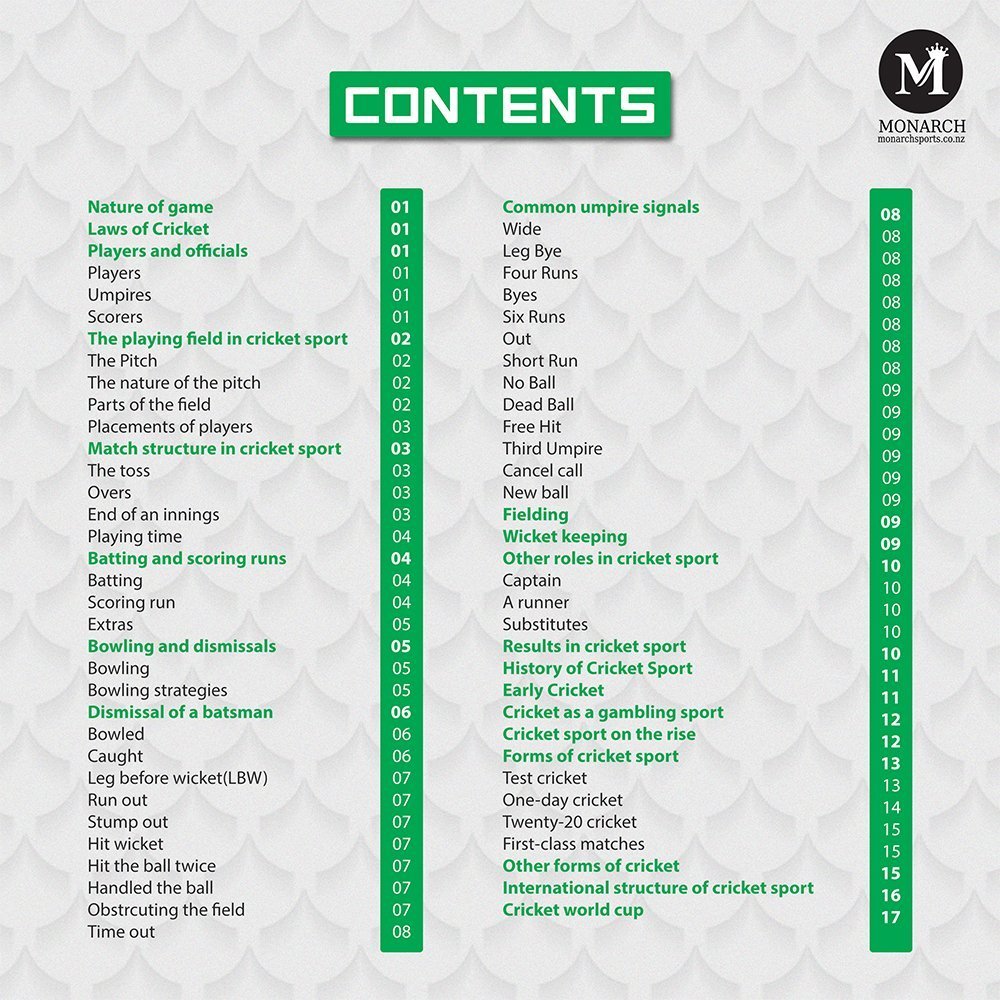
Nature of game
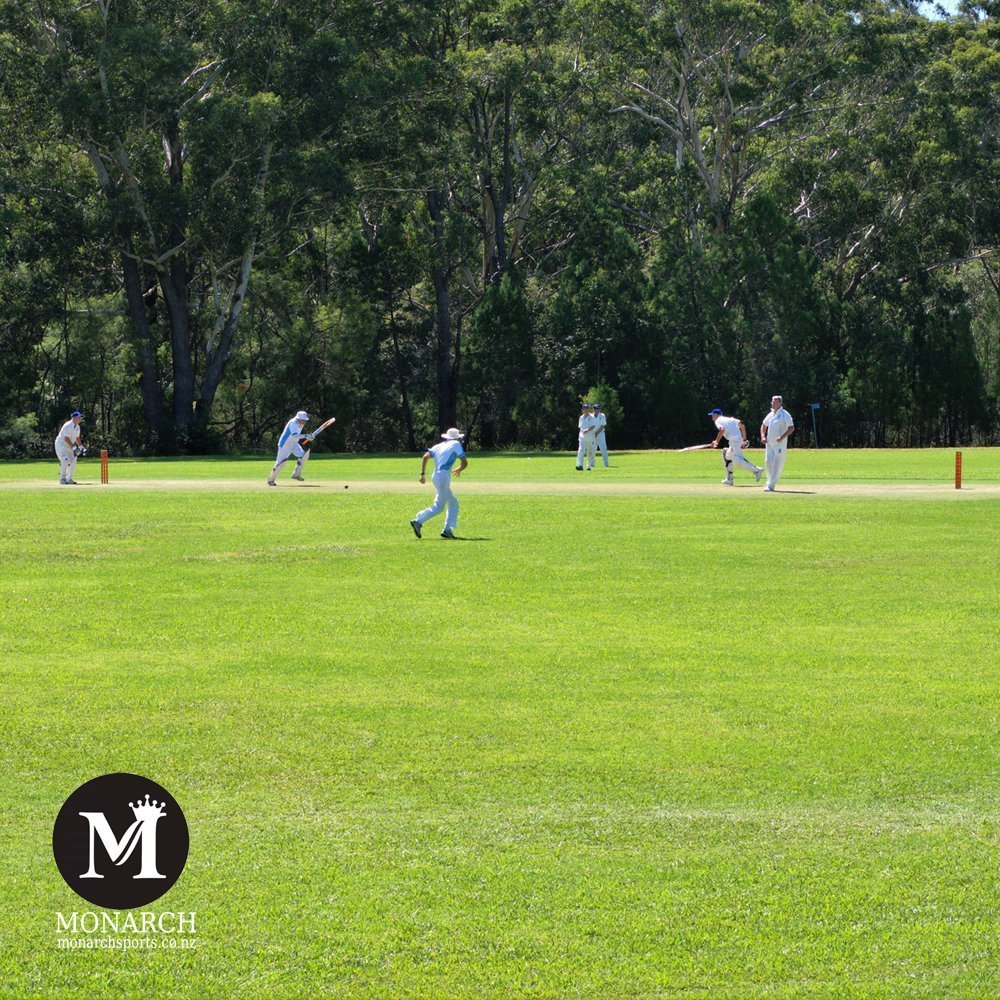
The cricket sport is a world-famous game that uses a bat and a ball. It is not as notorious as soccer or football that is popular in every country, yet there are millions of fans around the world of it as well. Two teams, each comprising of eleven players, compete against each other, and the contest usually lasts for one whole day.
One side has to score runs, and the opponent has to prevent the scoring by dismissing the batsmen through their bowling and fielding performances. After the dismissal of ten players, the sides swap and assume the roles to display their sportsmanship.
Laws of Cricket
Like every other sport, it also has a set of rules. The officials can alter them according to the nature of the match. A total of forty-two guidelines exist that the two can change with their mutual understanding. A group of umpires is also present to pass judgments on particular circumstances as per their understanding.
Players and officials
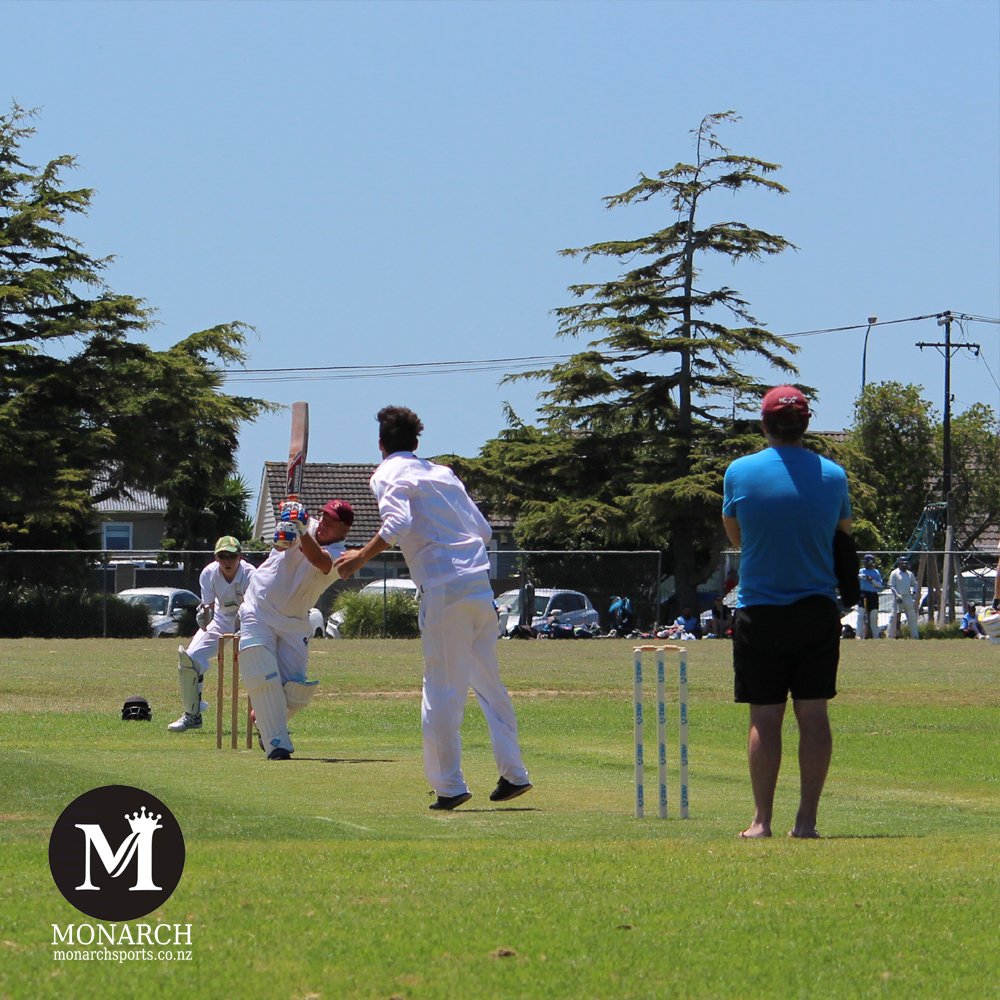
Players:
Each has eleven members in it. The three main categories are batsmen, bowlers, and fielders. The squads usually aim at a balance between the skills of the playing persons. The all-rounder, who excel in both domains and even fielding, is a valuable asset of a team.
Almost every set also includes an expert wicket-keeper, as this is a key position in defense. Earlier, this was not an essential element, but with the passage of time, it has assumed importance as well. The captain makes the strategic choices on the ground like the placement and order.
Umpires:
Each match has two ground umpires, one of whom stands at one end, also known as “bowler’s umpire”. This is a key spot as his verdicts are final in the majority of cases. Near the square leg area (within the fielding space), you can see the “square leg umpire”. The placement assists the main one as it allows another view of the whole scenario, especially the one bowling, and the batsmen as well.
The off-field referee, also known as ‘the third umpire” sits outside and reviews and aids in a verdict by referring to digital replays. This one also ensures the sanctity of the ones present in the ground and can challenge any of their pronouncements, based on the digital evidence present.
Scorers:
Each game has two scorers from both sides. They keep the certified record of the runs made, dismissal of wickets, and the over bowled in the cricket sport. They keep the record according to the referees’ signals and have to regularly check it with each other and the umpires during intervals. In addition, they also track the rate, analysis, and other averages included.
Also, the casual record keepers appointed by different media agencies also keep these records and rectify if there is any mistake. The errors of the scorekeepers, on the contrary to referees, are easy to fix and correct later.
The playing field in cricket sport
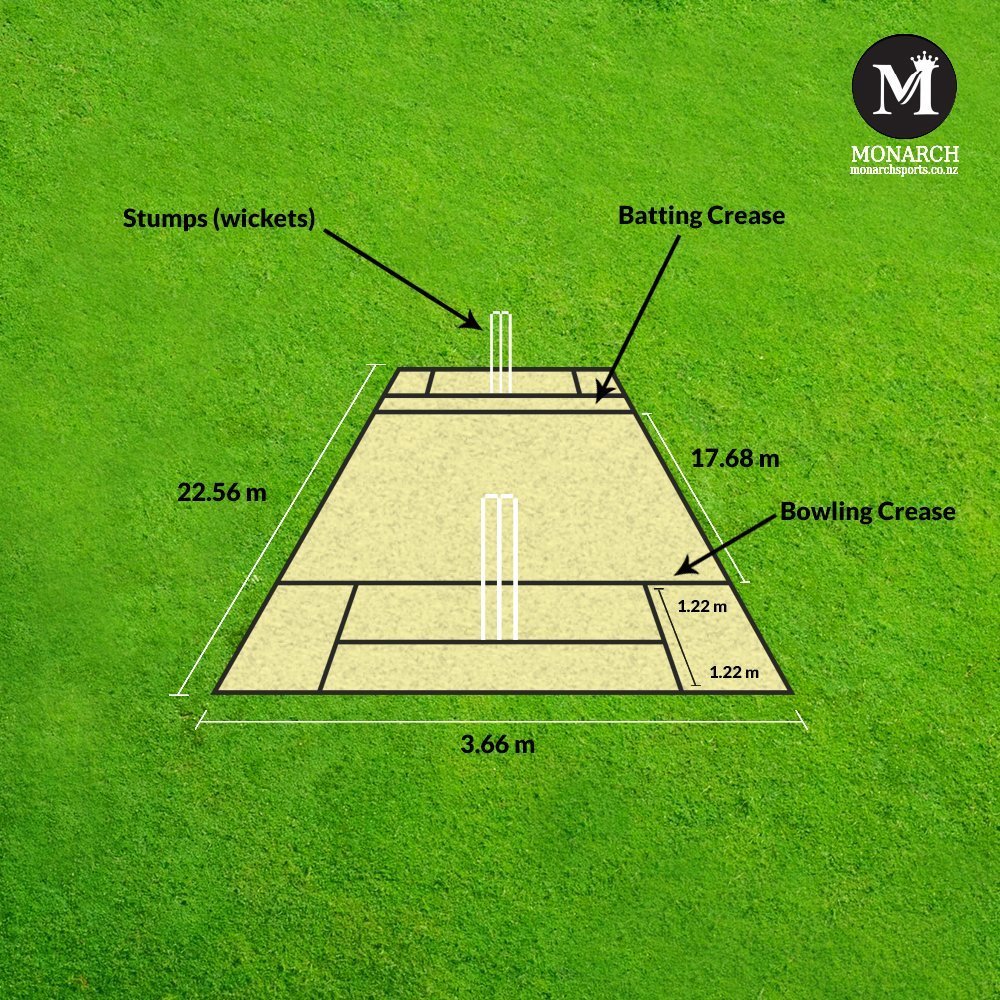
The playing area is usually grassy in oval or round shape. The diameter can be anywhere between 450 feet to 500 feet. However, there are vast arenas like Melbourne Cricket Ground and the Lord’s in London that expand over 5.5 acres.
A rope demarcates the margins; this is known as the ‘boundary’. The surface should ideally be level, either with natural or artificial turf. The layering of artificial turf and matting on a firm base is a good alternative where the natural alternative is not available.
The Pitch:
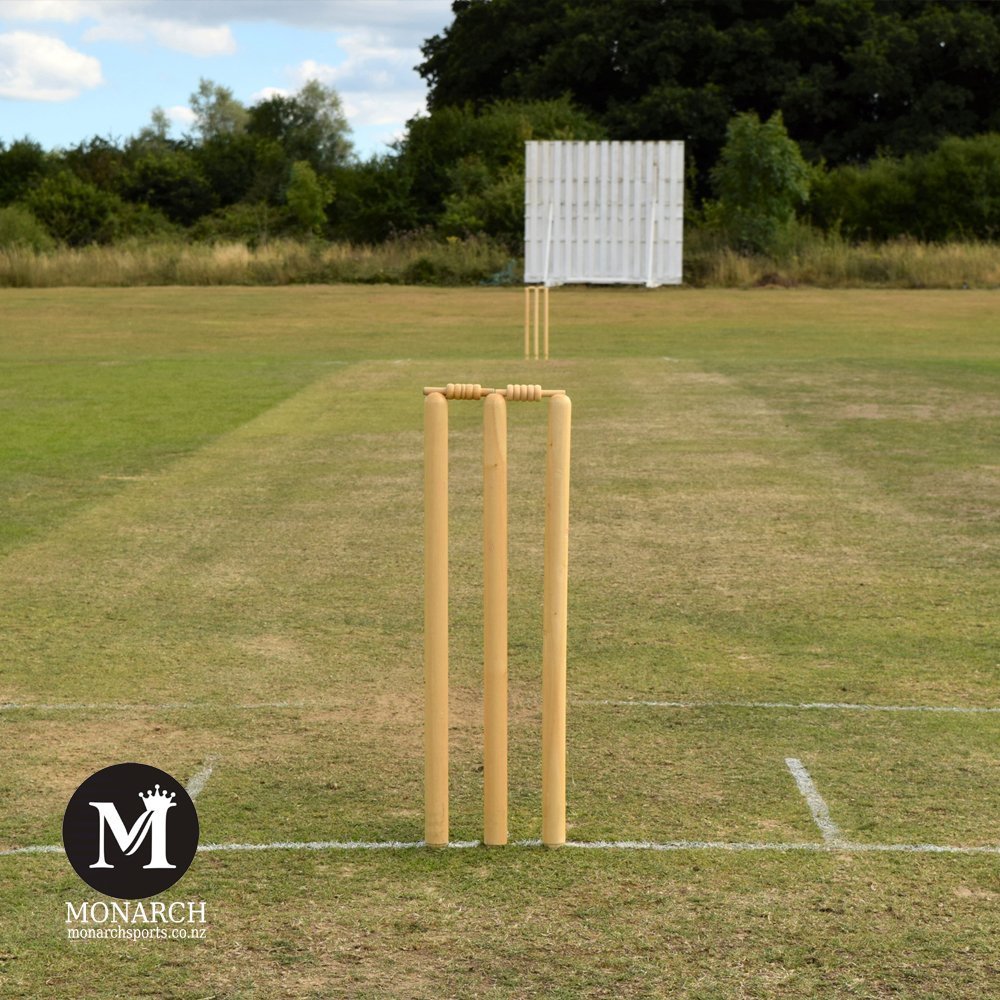
The rectangular strip in the middle of the playing field is known as pitch. This is the place where the action initiates and takes place most of the time. It is 66 ft long and 10 ft wide with short greenery on the surface. At each end are the three ‘stumps’ that are wooden sticks nailed into the soil.
On top of these, horizontally rest the bails on grooves, which are the smaller wooden sticks linking together the upright ones. Altogether, the three vertical stumps with two shorter horizontal bails constitute the ‘wicket’.
A whitewashed line can is visible 4.33 ft. beyond each wicket, on either end, people call it the crease. These creases determine the limit for both batsmen and bowlers. If the batsman happens to be out of this demarcation during the action and the bails are blown, then he is out and his turn is over.
Similarly, if a bowler’s rear foot goes beyond this limit, the ball is invalid and known as a ‘no’ ball. The position in front of the batter is known as ‘off-side,’ and the opposite one is ‘leg-side’ or ‘on-side’.
The nature of the pitch:
The main area in the middle matters the most and hence determines the performance of both spots. Its condition establish the bounce, spin, or seam movement of the ball, resulting in better or worse bowling act.
If it is too hard, it gives a boost to batting because of high bounce. But at the same time, a drier one develops cracks which lower batting performance. Such a situation is ideal for spinning maneuvers. The presence of dampness promotes seam movement or bounce, and aid fast bowlers. On the other hand, these tend to become better for batting over time.
Parts of the field:
The field has two areas: an infield and an outfield. Now, taking each wicket as a center, professionals draw a semi-circle of 30 yards across the breadth of the pitch. Then, joining the two semi-circles with parallel lines along the length to form an oval, marking the inward as infield and outside as outfield.
There is also a close-infield, demarcated by dots, in a radius of 15 yards around each wicket. These delineations are the limits to implement placements of fielders and other related restrictions.
Placements of players:
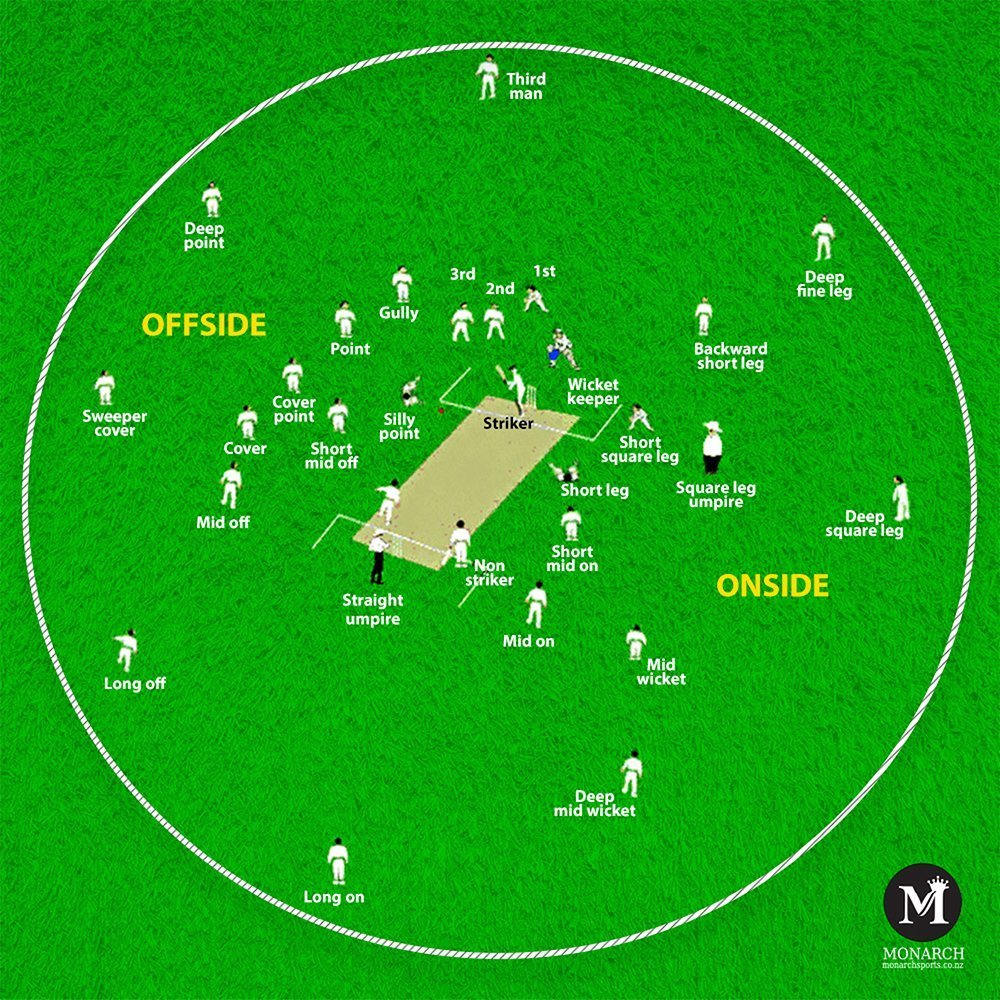
Two batsmen occupy the field for batting at a time. The striker faces the bowler, and the non-striker occupies the other end. The opponents have eleven players on the turf, including the one bowling. Also, it is a practice to rotate the bowler after each over.
One fielder stays behind the stumps at the striker’s end all the time, serving as wicket keeper. The rest of the nine players spread all around the stretch. They aim to catch the ball after the striker hits it. The strategic placement of the fielders depends on several factors like; the overall condition of the pitch, ground, moisture levels, batsman, and the nature of bowling.
Match structure in cricket sport

The toss:
It starts with the ritual of toss by flipping a coin. The two heads face each other and determine who bats first. The decision is based on various aspects; the nature of the pitch and the weather conditions like moisture in the air determines how the pitch will be for the performance.
It might become drier and deteriorate the batting average or gets better to bring more bounce for improved strikes. The kinds of players that are there in a squad also drive the captains to take up either role for these reasons.
Overs:
An “innings” is the turn that each one takes for its assumed role. One bowler gets to deliver six consecutive throws, collectively known as an over. No bowler can have two successive overs in an innings. After completing an over, each one assumes his fielding role, and another one takes over to the bowl.
After an over has taken place, both ends swap their places, and the adjustment of fielding roles takes place accordingly. Even the umpires exchange their places.
End of an innings:
The following are the conditions that cause an inning to be over:
- The bowling squad dismisses ten batsmen. The umpires have to declare them out.
- If there is only one player on strike and that is due to unavailability of another player for any reason.
- The squad chasing the score manages to make it within the given number of deliveries.
- In one-day, the number of bowling overs, which is usually 50, are complete already.
- Alternately, in a test-series, the head of either side can declare the inning closed.
Playing time:
In the early days, a test match used to take three to five days. There are two innings, each one lasting at least six hours every day. One-day matches have one innings for almost six hours. Each day, there are breaks for lunch and afternoon tea. Moreover, there are short intervals for drinks as well. Both sides also get some time off after the dismissal of one. This results in switching of roles of both squads.
Dry weather is a must for a match as rain means no game at all. This is because the pitch does not allow any action when wet. In addition to this, the low light in such weather also hinders any gaming activity. Due to the fast nature of the game, light is critical, so that the players can see the ball clearly.
Of late, floodlights make it possible to continue day and night matches as single day games. It is quite a thrilling experience for the audience, as well. However, it only happens in one-day and twenty-20 matches. Professional cricket is traditionally an outdoor game, but academies do make use of indoor pitches and turf for practice and training.
Countries like England, New Zealand, Australia, Zimbabwe, and South Africa usually have contests in summer. While India, Pakistan, Bangladesh, Sri Lanka, and West Indies enjoy the shows in winter as monsoon and hurricanes are common in these regions during summer months.
Batting and scoring runs
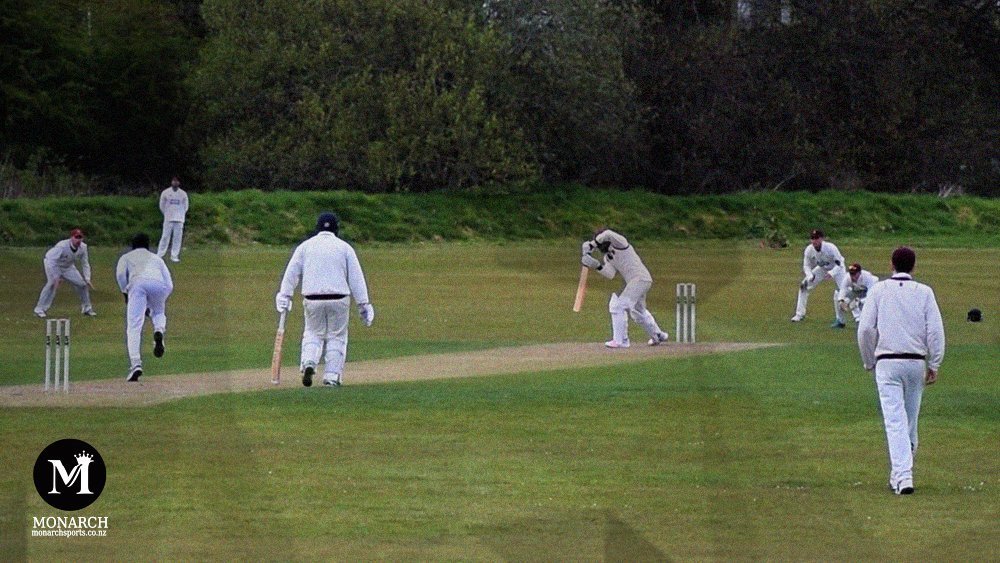
Batting:
The striker, who hits the ball with a wooden bat, occupies the stump against the bowler. Unlike the baseball bat, this one has a flat top surface, typically made of white willow. Each hit counts as a stroke or shot and that depends on the course it takes and the way it swings. The techniques for playing shots vary according to how the striker plays it. A ‘snick’ or ‘edge’ is when the ball just touches the bat and brushes against it.
The batting can be aggressive, defensive, or just jamming against the ball as per the need of the hour. Chasing a big score calls for aggressive action and big shots, while test matches tend to be slow with blocking the balls and occupying the pitch at most times. The batsmen have to run between the creases to score runs. A ‘sixer’ is when the ball hits the boundary without a bounce, whereas crossing the border while bouncing on the ground brings four runs.
The captain decides the batting order, and it can change at any stage as per need. ‘Openers’ are the ones who come to face first of all. They have to deal a new ball that assumes its seam action later in the game. The best strikers get to open the game, both on bowling and batting end. The skill level descends down the line, starting with the best, going down to all-rounder and the bowlers in the very end.
Scoring run:
When the striker hits the ball and runs to the opposite side, this is how he runs a score. This brings the non-striker in the front to face the next ball. Each one should physically touch inside the crease with their body or at least the bat to score a run or two if the shot has made it farther in the ground.
The batsmen spontaneously decide to run between the wickets according to the situation and by mutual understanding between the two using the hand signals or calling out to each other. They have to be fast enough to reach the opposite end before some fielder throws the ball to bail out the stumps. If the ball knocks out the bails before the batsman running towards the crease touches inside the line, he is run out. A scoring of an odd number of runs exposes the non-striker to face the next ball in front of the stumps.
The batsman gets a bounty of four runs if the ball crosses the boundary after touching the ground in between. However, he gets six runs, if the shot goes flying above the demarcation. The striker doesn’t have to run between the wickets to score a four or a six.
Extras:
Additional scores are counted as “Extras” as these are not attributable to any individual player. In Australia, the terminology of ‘Sundries’ is also used for it. These runs include no balls, wides, byes, and leg byes, and in some cases, penalty runs too. If the batsman misses a delivery and the wicket-keeper is unable to catch it; this leads to runs of byes or leg byes.
A ‘wide ball’ is when the delivery goes beyond the width of the crease. Similarly, a no-ball is also an error that while delivering the ball, the bowler’s heel doesn’t rest on the line and crosses it.
If a team member tempers the ball or wastes time intentionally or damages the pitch, the opponents acquire five penalty runs for these by the umpires. Fielders can only use their bodies to field. In case of violation, the batting group wins five runs. Likewise, there is an addition of five runs if a shot hits any object left on the ground by the opponent.
Bowling and dismissals
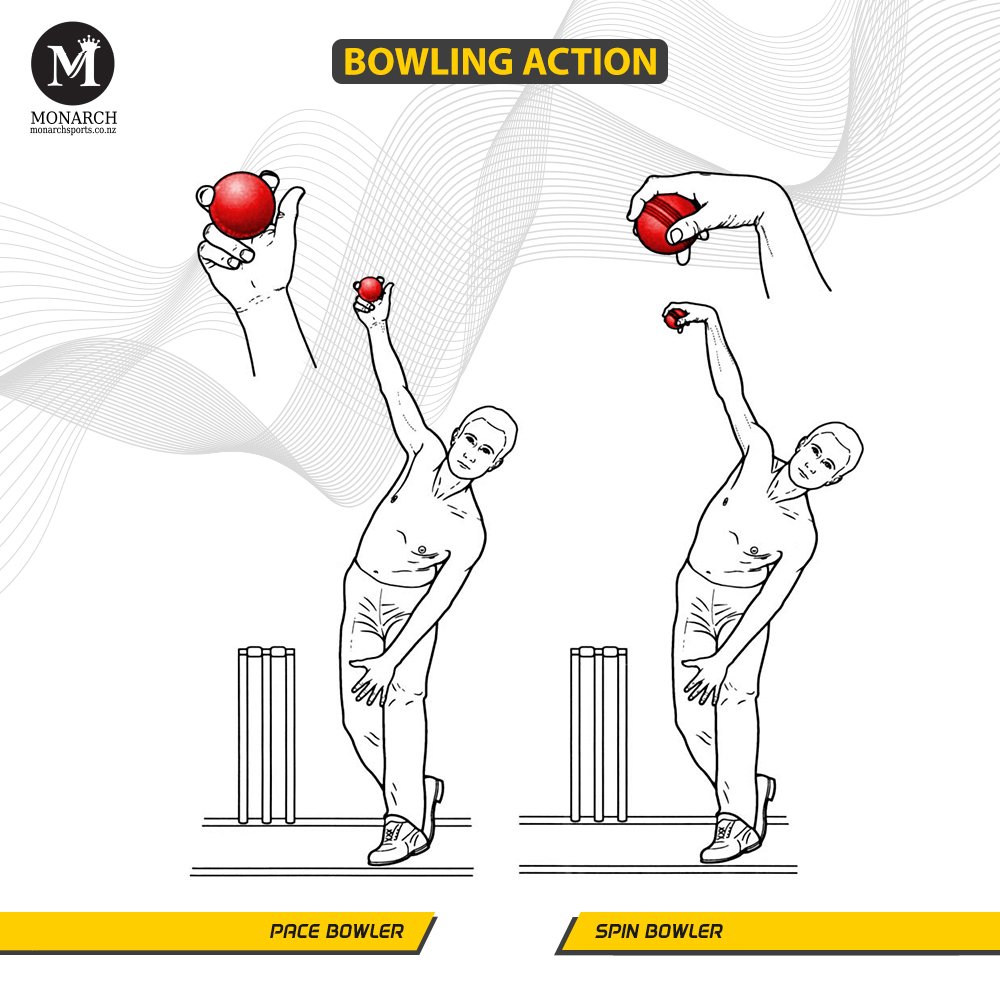
Bowling:
The unique skills of throwing speed and techniques are the basis for the selection of bowlers in each team. However, a few of them may also be an all-rounder with batting and fielding skills at hand just as well. The bowling specialists have to bowl only one over at a time that comprises of six consecutive throws. However, at the same time, one cannot bowl two consecutive overs at one given time.
The bowlers have to throw the ball overhand, and their elbow should not be bent. It can be both left-handed and right-handed. Most of them throw the ball after running through some distance behind the crease. This is called ‘pace’. Fast bowlers take a long run-up to gain momentum that boosts their delivery, speed, and propelling. Spin bowlers usually take a few steps before propelling the ball forward.
Bowling strategies:
Ideally, the ball should touch the ground before reaching the other end, but it is not necessary. ‘Bouncer’ is the delivery that flies straight to the batsman without touching the ground. A good ball is the one going a right length as far as the front of the striker as it leaves very less margin for the opponent to hurl and take a good shot.
Bowler’s specialty in cricket sport is to deliver the ball with maximum force at a speed of at least 90km/hr. It should bounce at full length on the desired spot, not allowing much time and space for the opponent to swing the bat and strike a powerful drive. This desired spot varies according to the bowler, the nature of the pitch and the batsman facing the delivery.
Other considerations in bowling:
The direction also matters considerably as it determines the quality of the throw. Spin bowlers turn around the ball on its own axis as it makes it way to the other end. This action allows the ball to curve either inward or outward after it bounces as it moves forward. In addition, this makes it a bit difficult for the batsman to judge the delivery.
Fast bowlers tend to change their pace to create an illusion of force. This way, it is hard to tell where it would land and in which direction. It certainly is a tough decision whether to move forward or backward to take a good shot.
They usually combine speed with swinging the ball, which again is difficult to judge, and lack of time with swiftness makes it even tougher to tackle. Such balls generally deceive the batsmen and result in dismissal after the ball barely touches the bat and goes straight in the hands of the slip fielders or the wicket-keeper.
Spinners mostly rely on spinning the ball at a slower pace that can be confusing at times due to its direction and constant swerves. Though not too fast, they are twirled and misjudged.
A “half volley” is a ball that bounces in front of the batsman and allows him to only partially drag it. The one that the striker takes on without letting it touch the ground is a ‘full pitch’ ball. ‘Yorker’ is an aggressive form that is hard to defend with a normal batting stance. It is an outstanding delivery as it lands right at the feet inside the crease. The ones falling at a short length on the pitch are termed as ‘long hop’.
Dismissal of a batsman
There are ten ways of dismissal of a batsman. The next batsman in the batting order replaces the dismissed one on the pitch. The dismissed one goes back to the pavilion. A team is declared all out after dismissing ten batsmen as the last one cannot continue alone.
Most dismissals in cricket happen when the bails go off the stumps with the help of the ball. Following are the different possible ways of dismissals:
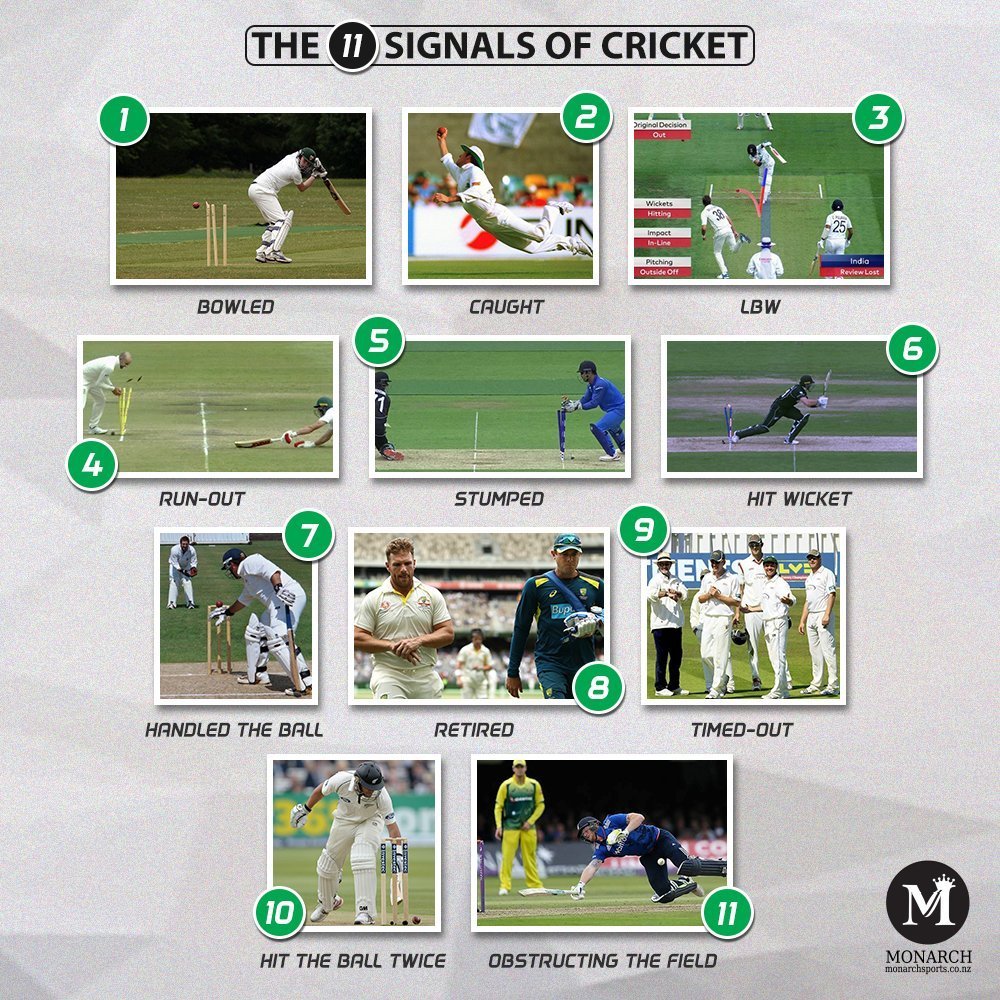
Bowled:
The batsman goes back to the pavilion, if the ball goes straight to the stumps and displaces one or both bails. The bowler gets the sole credit for this.
Caught:
If a fielder catches a shot before it touches the ground or bounces, the batsman is said to be caught out. Both the bowler and the fielder get the credits of the dismissal in the record. A ‘catch out’ is when a fielder catches a shot before it touches the ground or bounces. It is also possible even if the ball touches his glove instead of the bat. This usually happens when the ball touches the glove and the wicket-keeper behind catches it.
Leg before wicket (lbw):
The umpire passes a judgment of “lbw’ when the ball is not able to go to the stumps, but the batsman’s leg (or knee pad) or body comes in the way. However, lbw is not possible if the ball bounces outward, as this could not strike the wicket. On the other hand, the bowler gets the credit for the dismissal if the striker does not try to play a ball going outside the off stump.
Run out:
A ‘run out’ is when a ball is thrown into the stumps by a fielder, and it dislodges one or both bails while the batsman is still not inside the crease. It can be a direct hit, or maybe a player is holding the ball while removing the bails. No bowler gets the credit for run-outs. The records only have the name of the involved fielder in the brackets.
Stumped:
A batsman has to go back to the pavilion if he is outside the crease, and the wicket-keeper bails him out by throwing the ball in the stumps. The batsman should be inside the line when the bowling action starts. While he goes out to have a shot and misses it, the ball goes straight to the keeper who can dismiss him by removing the balls with a direct hit in no time, before he returns to the crease.
Both the keeper and the bowler get the credit of stump out. This is where the expertise of the keeper behind the stumps comes in handy. The sharp reflexes of the batsman are tested. If he misses the delivery, he better get back in his limit quickly. Stump outs are frequent during spin action in cricket sport when the wicket-keeper usually is at an arm’s length from the stumps.
Hit wicket:
If a striker knocks out one or both bails on the stumps with his body or his bat, this calls for his dismissal. This may happen while aiming for a shot or going off to take a run, and the bowler gets the credit for this dismissal.
Handled the ball:
A player is out if while facing the ball he deliberately handles or touches it without consent from the fielding. Nobody gets the credit for this dismissal.
Retired:
If a batsman is injured or falls ill (or for some other compelling reason to leave the field), he may retire and resume his innings when another batsman is injured or retires. . If he cannot return by the end of the innings, the batting team will have to close their innings after all the batsmen have been dismissed (except for the not-out batsman). This can happen if the batsman needs medical attention off the field. For the final bat of the match it is possible to lose despite losing only nine (or possibly fewer wickets). If the batsman cannot resume his innings, he is recorded as “retired – unbeaten”.
Timed out:
‘Time out’ is when a striker fails to replace a dismissed one within three minutes of his removal from the pitch. If this situation prolongs without any apparent, valid reason, the umpires have the authority to call the game forfeited and dismiss it. As a result of this rule, the batting side cannot misuse the time limit.
At times, a batsman might have to leave the ground if he gets an injury or falls sick; he is not out but being ‘retired ill’ or ‘retired hurt’. He can return later if he recovers before the end of the game.
The dismissal of only one striker is possible per delivery. However, a number of dismissals can occur without bowling in action. For instance, the non-striker can be run out by the bowler if he is out of his crease. Any batsman can go out at any time if he is obstructing the field or can go out retired hurt. Timed out is another dismissal without any bowling.
Hit the ball twice:
Another way of dismissal is when the batsman intentionally hits the ball twice to keep it from hitting the stumps. The bowler doesn’t get the credit for this.
Obstructing the field:
Additionally, when a batsman hinders a member of the fielding squad deliberately, he has to go back to pavilion. Neither the bowler, nor any fielder gets the credit for this dismissal.
Common umpire signals
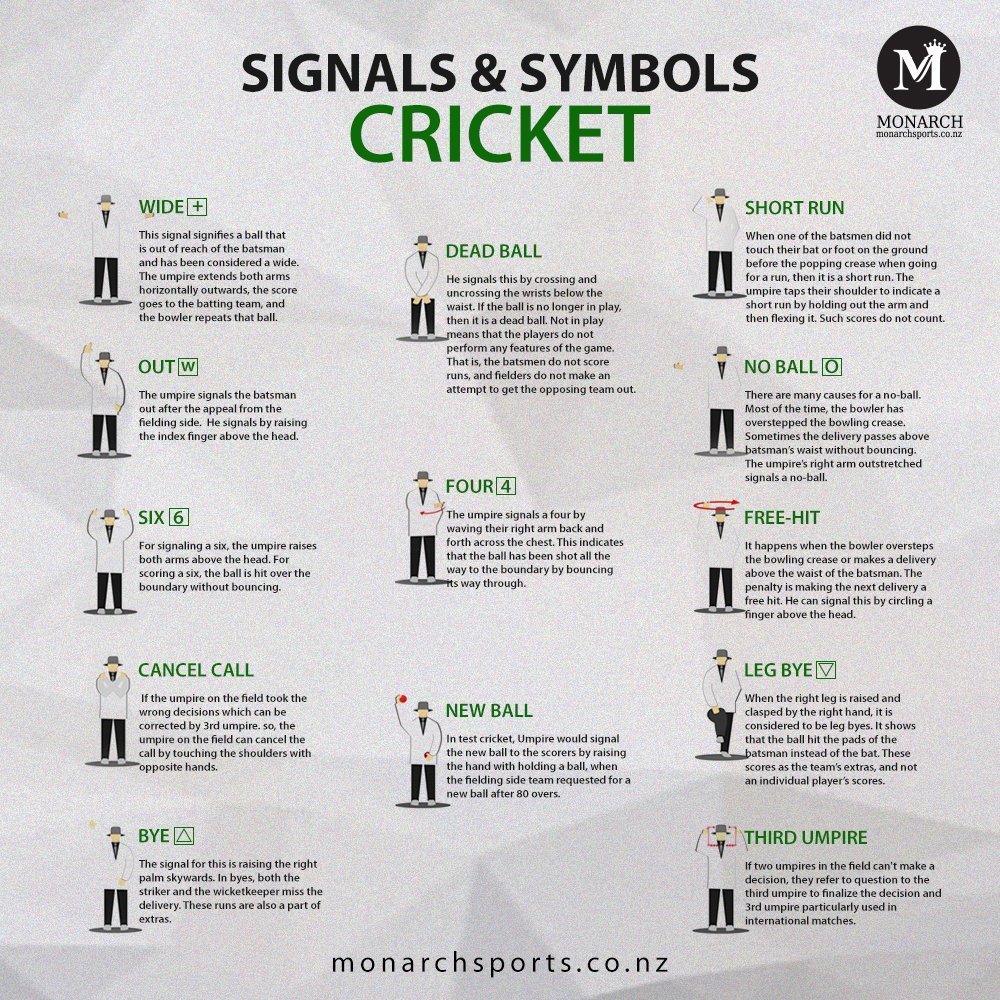
Wide:
This signal signifies a ball that is out of reach of the batsman and has been considered a wide. The umpire extends both arms horizontally outwards, the score goes to the batting team, and the bowler repeats that ball.
Out:
The umpire signals the batsman out after the appeal from the fielding side. He signals by raising the index finger above the head.
Six Runs:
For signaling a six, the umpire raises both arms above the head. For scoring a six, the ball is hit over the boundary without bouncing.
Cancel Call:
If the umpire on the field took the wrong decisions which can be corrected by 3rd umpire. so, the umpire on the field can cancel the call by touching the shoulders with opposite hands.
Bye:
The signal for this is raising the right palm skywards. In byes, both the striker and the wicket keeper miss the delivery. These runs are also a part of extras.
Dead Ball:
He signals this by crossing and uncrossing the wrists below the waist. If the ball is no longer in play, then it is a dead ball. Not in play means that the players do not perform any features of the game. That is, the batsmen do not score runs, and fielders do not make an attempt to get the opposing team out.
Four Runs:
The umpire signals a four by waving their right arm back and forth across the chest. This indicates that the ball has been shot all the way to the boundary by bouncing its way through.
New Ball:
In test cricket, Umpire would signal the new ball to the scorers by raising the hand with holding a ball, when the fielding side team requested for a new ball after 80 overs.
Short Run:
When one of the batsmen did not touch their bat or foot on the ground before the popping crease when going for a run, then it is a short run. The umpire taps their shoulder to indicate a short run by holding out the arm and then flexing it. Such scores do not count.
No Ball:
There are many causes for a no-ball. Most of the time, the bowler has overstepped the bowling crease. Sometimes the delivery passes above batsman’s waist without bouncing. The umpire’s right arm outstretched signals a no-ball.
Free-Hit:
It happens when the bowler oversteps the bowling crease or makes a delivery above the waist of the batsman. The penalty is making the next delivery a free hit. He can signal this by circling a finger above the head.
Leg Bye:
When the right leg is raised and clasped by the right hand, it is considered to be leg byes. It shows that the ball hit the pads of the batsman instead of the bat. These scores as the team’s extras, and not an individual player’s scores.
Third or TV Umpire:
If two umpires in the field can’t make a decision, they refer the question to the third umpire to finalize the decision and 3rd umpire particularly used in international matches.
Fielding
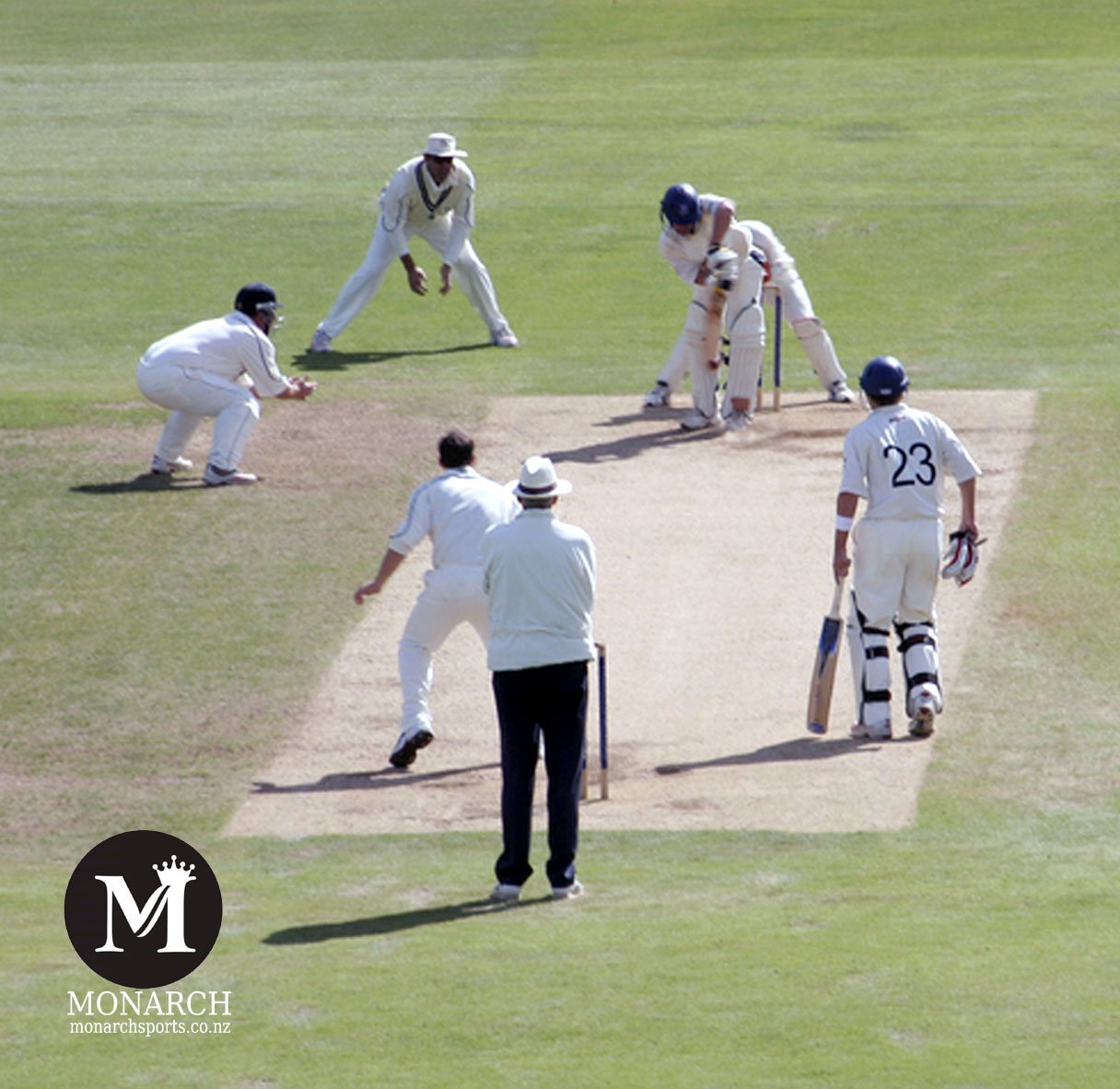
Fielders are the players that assist the bowlers in keeping the scores in check and dismissing the opponents. They have to intercept the shots by the strikers and return it to the wicket-keeper and, whenever possible, hit the stumps to run out the batsmen. The fielders can do this by using any part of their bodies and they can move in any direction they want.
Only the wicket-keeper wears hand gloves or a helmet sometimes when a fast pace bowler is in action. The rest of the fielders do not get to wear any gears.
The players who are good at fielding, along with either batting or bowling or both, are termed as all-rounders. Certainly, they are a valuable part of cricket sport. The fielding requires fast running, safe diving along with practicing quick and accurate throws back towards the stumps.
Their alertness and reflexes can prevent the scoring of runs. They have to keep an eye on the action on the pitch to anticipate the upcoming shot. This not only helps to intercept the stroke but also to seize the catches to dismiss the strikers.
Wicket keeping
The wicket-keeper is the one who specializes in fielding behind the stumps. He usually occupies the striker’s end at a distance of a few feet or10 to 15 yards depending on the bowler. His task is to collect all the deliveries from going into the outfield if the batsman is unable to hit them. If they go out unattended, the batsmen can score byes. Being at a risky position, the wicket-keeper wears gloves and covers the lower legs with pads.
Quick reflexes are an essential prerequisite for this position. He has to keep a close eye at every ball and gather each one that escapes the batsman without touching or has just a fine edge. He is the only one who can stump out the striker. Also, he has to receive the throws from other fielders to take a chance for a run-out.
Other roles in cricket sport
Captain:
The head of the team has a very strategic role to play. His insight determines the performance of the team, especially in crucial situations. He is the one who decides whether to bat or field after the toss. There are several factors to keep in mind while taking this decision.
The weather conditions, state of the pitch, and what kind of players both teams have, teams matter a lot in making this decision. He has to arrange the players in the ground and assign them their positions for fielding. In recent years, in international one-day matches, the captain also has to decide when he is going to have the Power Plays.
A runner:
At times, a batsman is able to bat but cannot run properly due to an injury or some illness. In such a scenario, the fielding captain and the umpire can allocate another player from the batting side to serve as a ‘runner’. Preferably, the runner should have dismissed earlier. He only has to run between the creases in place of the batsman. The runner, as per rules, carries the same gear and equipments as the batsman that he is running for.
Substitutes:
If a player falls sick or gets an injury, a ‘substitute’ can take his place and field. However, he cannot bat, bowl or be a wicket-keeper. Once the player becomes fit enough to return to play, the substitute leaves the playground.
Results in cricket sport
When all the batsmen of the team batting later go back to the pavilion without being able to score the desired runs, it loses the contest. In short, it loses the competition by the number of remaining runs. Conversely, if the latter manages to exceed the run total that it is chasing, then it wins the competition by the number of wickets in hand.
In test-matches where each side has two innings, the results are based on different calculations. If one team’s total score of two innings is less than the rating of only one inning of the opponent, then they don’t have to bat the second innings. They win the game by the margin of whole innings.
A match is ‘tie’ if the team batting has all batsmen dismissed, and the scores of both teams are exactly equal. It happens very rarely, especially in test contest. Traditionally, a game is ‘draw’ if neither side could win within the designated time. But it does not happen anymore, as floodlights solve the problem of low light that forced the games to end earlier.
One-day cricket sport has one innings for each team. Moreover, each innings has a set number of deliveries. The team scoring more runs is the winner irrespective of the fact that which side loses more wickets. On the other hand, Duckworth-Lewis method determines a new target if bad weather conditions interrupt the game.
It is a complex formula that keeps various factors into consideration while calculating the original target score. ‘No result’ for a match takes place in case of prolonged bad weather. This happens only when there are already a set number of overs for each innings and the bowling overs are fewer.
History of Cricket Sport
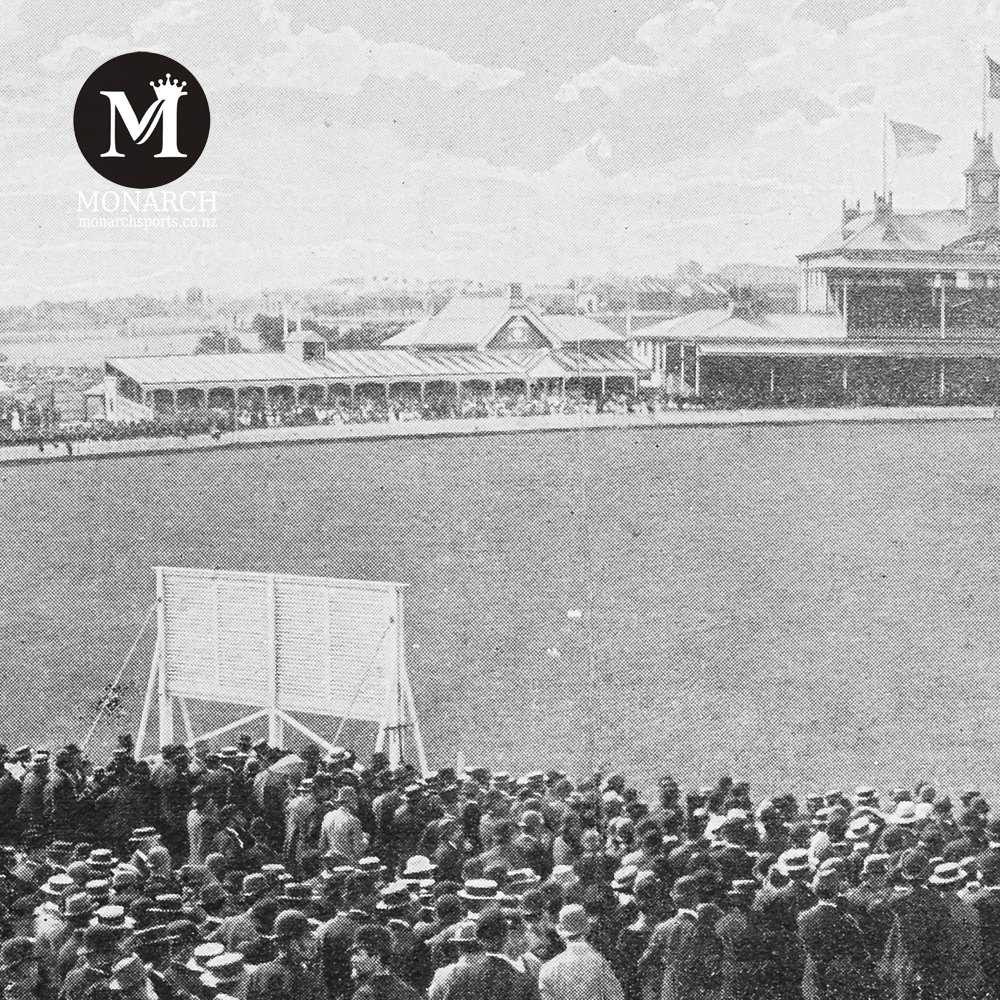
At its earliest, the origin of cricket goes back to the thirteenth century. However, there are suggestions of this game having existed even earlier than this time. The sport appeared to have origins in the area between Sussex and Kent, known as Weald, where the children of the farming and metalworking people usually played it.
There is a proof of a game by the name of “Creag” that Prince Edward, son of King Edward I, played in Newenden, in 1930. As per Oxford English Dictionary, the first recorded occurrence of cricket refers to a sport at the Royal Grammar School in Guildford called “kreckett’.
To sum up, there is a variety of words present throughout the history. They serve as alternate forms of the word ‘cricket’. The term for the cricket bat may have come from an old English word “crycc” (meaning meaning a stick or a staff), or old French “criquet” (meaning a kind of club) or Flemish “crick” (meaning a kind of stick); though some people say that some of these references seem to be controversial as per their etymology and the provided evidences.
On the other hand, the French word “croquet” seems to evolve from the Flemish word “krickstoel”. It is similar to the long low wicket that people used early on in cricket sport.
Early Cricket
The original record of a cricket sport with 11 players on each side dates back to 1697, played on a bet of 50 guineas in Sussex. Counties of Kent and Surrey played the earliest recorded inter-county game at Dartford. Around this time a set of rules likely existed for carrying out the game, even though the first evident set of rules existed in 1744.
Evidences point to the fact that during the early 18 th century, cricket was prevalent in only England’s southern counties, although it became more popular with time and spread to the rest of England. It was normal to have unruly crowds, in addition to heavy betting.
All- England and Kent came face to face in a notoriously famous match, at the Artillery Ground in Finsbury, London, in 1744. In the second half of the 18th century, the Hambledon Club, which initially played at Broadhalfpenny Down. This was only until the augment of the MCC, which was originally a cricket club that played at the White Conduit Fields.
Cricket in earlier centuries
After the club moved to the Lord’s Cricket Ground in St. Marylebone Borough in 1787, it became the Marylebone Cricket Club. The following year, the MCC put out its first laws of cricket. The name Lord’s comes from its founder, Thomas Ford. After moving to its current location in St. John’s Wood in 1914, it has become the center of world cricket.
As proof of the widespread popularity of cricket, northern and southern counties played against each other in 1836. The All-England XI started its tour around the country in 1846. This was the initiative of Nottingham’s famous person, William Clarke.
In 1852, several leading professionals constituted the United All-England XI. These two teams went on to engross the most exceptional cricket talent, that is, until the rise of county cricket. In 1859, these teams provided the players for the first English cricket team touring overseas.
Cricket as a gambling sport
The cricket sport witnessed tremendous growth in Southeast England during the seventeenth century, according to several references in various forms. It took the type of organized activity that took place as a venture. The early professionals of the game must have emerged during that period as a result of high stakes.
The earliest pieces of evidence refer to a contest in Sussex in 1697. The game included 11 players and had a big bet placed on it. The betted amount was 50 guineas, which was a handsome amount as per that era.
This betting trend had a massive impact on the game, and it drove wealthy patrons to hire players and form their own squads known as ‘Select XIs’ in those days. Good players were in high demand for vast sums of money and guaranteed the success of a squad. Additionally, there are frequent references of masses gathering in the famous Artillery Ground situated in Finsbury. This shows the popularity of the sport in the early 1700s in London and its localities.
Cricket sport on the rise
Surrey and Kent played the first recorded match in England, on the 29 th of June, 1709, at Dartford Brent. Cricket became the national sport of England by the end of the eighteenth century, after having undergone paramount improvement. One great example of these improvements was the initiation of the player system, which greatly resembles the system that many sports use in the present time.
The union of players consisted of two kinds of players: those who wanted to play only with the Lord, and those who were at liberty to perform for whomever they wished to. The Hambledon Club (formed in the 1760s) was playing first-class matches since 1756.
This club ranked as the greatest cricket sport club for almost 20 years, until the creation of the MCC, or the Marylebone Cricket Club. The establishment of the Lord’s Cricket Ground in 1787. After its establishment, the Marylebone Cricket Club quickly became one of the best cricket clubs in Britain, and soon, the creators and guardians of the laws of cricket.
Round arm bowling and over arm bowling took place of under arm bowling in the nineteenth century.However, both of these replacements were meet with a lot of controversies. First introduced in the 1820s, the concept of a “champion county” led to the formation of many county clubs, such as the Sussex CC in 1893. It ultimately led to the creation of a County Championship.
Increasing popularity
The first team of English players that went on an overseas tour was in 1859 to North America. Almost 18 years later, in the first-ever test match at the Melbourne Cricket Ground, another English cricket team played against Australia. In 1864, well-renowned cricket legend W. G. Grace started his extensive career and has the honor to make numerous developments in the cricket sport and further increase its popularity.
The last two decades before the First World War produced some of the best players and terrific matches, notably as organized test and county matches improved. We still remember this as the “Golden Age of Cricket”. Don Bradman, who is statistically the best batsman of all times, dominated the years between the two world wars. Resolved to triumph over Bradman’s skill, the English team in 1932-1933 developed the well-known Bodyline series.
In 1963, the English side modified the cricket rules to introduce an alternate match form. Each side would have only a limited number of overs. This development proved to be majorly popular, and in 1971, led to the creation of ODI, or One-Day International.
The governing International Cricket Council quickly took up this new match form. The first ODI Cricket World Cup took place in 1975. Since the longer form of the matches no longer took place, ODI gained massive audiences, although at the expense of the dismay of fans who favor the longer style of the game.
Since the early 2000s, the longer form of the game has seen new growth in popularity. However, the limited over the type of the game, known as Twenty20, has had a much more instantaneous impact.
Forms of cricket sport
There are three primary forms of cricket sport played professionally at the international level, namely One-day international, Test cricket, and Twenty-20.

Test cricket:
This form of cricket started back in 1877, while the English team was on its tour in Australia. The first game between two national teams was between England and Australia in Melbourne on the 15th of March, 1877. It had only four balls per over and a timeless format. Australia won the match by 45 runs, ending on March 19.
The general public knows this test series as ‘Ashes’ now. This name has an interesting story. After winning the first series, Australia won again in 1882, in the series played at Oval in London. A leading sports journal, “The Sporting Times” issued an obituary notice. The obituary said to cremate English cricket and send the ashes to Australia. There is an urn with ashes of the burnt bails from this England- Australia tour. This urn is present at the Lords currently.
The two countries faced each other annually until the end of the century. The English team had a prominent Victorian cricketer, W.G. Grace, while Australia had F.R. Spofforth, who was a great bowler of his time. J.McC. England was a tough opponent for Australia in the Ashes, although Blackham, an excellent wicketkeeper of the early days, was in the Australian team in those days along with the great bowler F.R. Spofforth.
Since that day, the number of teams playing in this series has risen to 10. So far, more than 1800 games have been conducted in this series. Bangladesh is the latest addition to this series in 2000, after acquiring Test status.
Test cricket matches:
Each test cricket sport has two innings that span over a period of five days, though sometimes the game is over before that. In older days, test competitions stretched over six days or even timeless to get to a result. When a contest is not successfully completed in time designated for them, “Drawn” is the terminology normally reserved for them. In short, they are over instead of carrying on further.
In the 1960s the Test cricket witnessed numerous crises due to various reasons. South African apartheid became the reason for the cancellation of its tour to England in 1969-70. There were threats of violence and disruption by the political activists.
Meanwhile, an executive from a leading Australian television network, Kerry Packer, signed a number of world-class players for a private series between 1977 and 1979. The matter was taken to court with retribution suggested against the players, but it was overruled in England. This marked the start of the commercialization of the game.
Troubles during test matches
However, in 1982, 12 English players faced a ban of three years from playing test cricket. They had signed for 50,000 Pounds per head for a commercially sponsored South African tour. This was against the official guidelines for the first-class players in the national team.
Later, Sri Lankan and West Indian players also had to face strict disciplinary actions for their commercial South African tours. Later on, the involvement of English professionals in the South African team as coaches and players also created a breach among the Test-playing nations.
Match-fixing scandals took test-cricket by storm in 1999. Nonetheless, betting was an essential part of this game since its early days. However, many countries have banned it in the modern-day. The countries which had legalized betting also faced consequences later.
A number of cricketers later testified that people in this betting business contacted them to underperform in return for huge sums of money. This not only brought a bad name for the players but the whole squads where everyone might not have been involved. More than a few players had to leave the cricket sport for good after tainted reputation. This had a negative impact on the integrity and sportsmanship of the players and the game as well.
One-day cricket:
Since test matches were more time consuming, as a result of this England introduced one-day games in cricket sport in 1963. This was the need of the day to have a short form that would bring in more thrill and drama for the spectators. The English domestic season brought in single innings for each side with limited overs. International cricket adopted this form in 197. During the third test between England and Australia, rain disrupted the game and a match was played on the fifth day.
ODI is the common name for one-day contests. However, LOI (Limited Overs International) is another less common name for them. They are totally crowd flocked, especially in the countries that started cricket sport later in the 20 the century. The single-day game is far more thrilling and power-packed than tests. Indeed, it has generated a huge audience in the stadiums as well as for TV channels all over the world.
Twenty-20 cricket
This form of cricket originated in England in the domestic arena in 2003. It was an attempt to increase the popularity of the game and draw more audience. Since the day, fans from all around the globe admire and play this form everywhere. It consists of one innings for each side with only 2o overs. The boundaries are shorter, and specially made pitches are batting-friendly.
Many other rules are formulated for this new form of the game, like getting a free-hit after a no-ball. These quick, fast-paced matches packed with action attract more spectators who do not show much interest in slow-paced old forms of the game.
Australia and New Zealand played the first ever international Twenty-20 match for men, in 2005. The first match for women was between England and New Zealand, in 2004. In March, 2006 ICC announced the event of Twenty-20 World Championship every alternate year. South Africa hosted the first one back in 2007.
First-class matches
The first-class cricket sport are the ones that take place at the international level. The domestic matches played on natural turf are also rated as first-class if they meet other standards as well. These ought to have at least two innings for each side. The game is declared drawn if it does not finish within the allotted time. One-days are not included in this category as they have only one inning per side.
The two teams playing should also have the first-class status, only then a match spanning over at least three days, with two innings is granted this status. These include all test matches, games between domestic teams that hold ICC membership, games played by test nations, etc.
For instance, Kenya is an associate member of ICC. Its domestic matches are not a part of the first-class. However, games between Kenya and any other first-class team from the members of ICC (whether domestic or national squad) are also rated first-class. According to sports historians, this form dates back somewhere between 1660 and 1864; yet there is no concrete evidence to prove this stance.
Other forms of cricket
The rules governing the game have evolved a lot since the beginning. International cricket has modified the rules to meet the commercial needs and earn more fans over the years. The formal games at the domestic level and local clubs usually span over one or two days with a limited number of overs.
Nonetheless, at a lower level, the rules are often modified to compensate limited resources and other restraints. All these modifications, one way or the other, make the game more playable and enjoyable for the players, as well as the spectators.
The varying conditions allow for as many changes as both sides would agree. As the cricket sport is not always played on turf, alterations are inevitable. Youngsters usually enjoy cricket in the streets or their driveways and backyards. Other variations may be the sandy beaches or the rocky playgrounds.
More Varieties
In South East Asia, “Tapeball” is a variant that is quite notorious amongst masses. In it, tennis balls covered in tapes are used as a substitute, as it is more practical and affordable. Similarly, homemade bats like any flat wooden thing are also a replacement.
All sorts of different objects serve as wickets, or sometimes they are merely drawn on a wall at the back for indication. The number of players in each team varies as per the people available for playing. People improvise and adjust rules for all the different factors at hand.
Kwik cricket draws more appeal for children as in this game. The bowler does not need to wait for the striker to be ready on the crease. This is faster and strenuous and mostly a part of PE lessons at schools.
“Tipsy Run” is a witty alteration that certainly increases the pace of the play. This calls for the striker to run as soon as the ball hits the bat, whether it is intentional or by chance. This rule aims at dismissing the batsmen quickly as well as not letting them block any delivery. In Samoa, a similar competition by the name of “Kilikiti” is notorious; it uses hockey sticks that look quite similar to bats.
International structure of cricket sport

All around the world, more than 120 countries play cricket in the International Cricket Council. It comes second in popularity after football and is known as “gentlemen’s game’. As it originated in England, hence is the national game of not only England but of The Bahamas too.
Furthermore, it is equally famous in English speaking nations like Scotland, Ireland, Australia, and New Zealand. South Asian countries celebrate it; for instance, Nepal and Bangladesh as well as India, Sri Lanka and Pakistan. Its fame further spreads to Afghanistan, United Arab Emirates, Bermuda, and Cayman Islands. Caribbean countries, are commonly known as West Indies, also actively engage in this sport.
It does not have many fans in European countries. However, some African nations like Kenya, Zimbabwe, South Africa, Namibia, and Uganda play cricket enthusiastically.
International Cricket Council (ICC) is the international governing body with its headquarter located in Dubai. The ten test-playing countries have their representatives in it. In addition to that, the non-Test-playing countries have a panel of elected members for representation.
Each country has its own national board of cricket that takes care of all the related affairs. This governing body regulates all the games played in the country and the contests taking place. It is also responsible for the selection of the national team. In addition, they organize and manage all the domestic and international tours.
Cricket sport playing nations come into three levels according to the infrastructure of the game in the country. Test-playing is the highest tier; they automatically qualify for the World Cup tournament, every four years. Then are the Associate Member nations, and finally, the lowest tier is of Affiliate Member nations.
Cricket world cup

The cricket authorities decided to have an international competition in 1912. England, Australia, and South Africa were a part of an arranged meeting. However, this effort was in vain due to adverse weather conditions. The idea was stagnant until 1975. It came to life after successful one-day competitions at the local level in different countries.
At that time, there were six test-playing nations: Australia, England, India, New Zealand, Pakistan, and the West Indies. These six countries came together with Sri Lanka and East Africa in 1975. The first world cup was played in England. The event was a huge success and was played every four years in England until 1983. After that, it was held every fourth year but in different countries.
The number of teams participating in 1992 was still 8. It increased to 16 in the 2007 Cricket World Cup. 10 teams participated in the latest 2019 Cricket World Cup held in England. Australia has shown extraordinary performance and claimed almost half of the trophies, i.e., 5, including a hat trick.
The winners of the tournament up till now are as follows:
- West Indies: Won the World Cup in 1975 & 1979
- India: Won the World Cup in 1983 & 2011
- Australia: Won the World Cup in 1987, 1999, 2003, 2007 and, 2015
- Pakistan: Won the World Cup in 1992
- Sri Lanka: Won the World Cup in 1996
- England: Won the World Cup in 2019
Cricket sport has evolved a lot over the years. For decades to come, it is going to be one of the most enjoyable games around the globe.


There are no comments